The Pork Food Chain as a Route of Transmission of Antimicrobial Resistant Escherichia coli: A Farm-to-Fork Perspective
Abstract
:1. Introduction
2. Results
2.1. Escherichia coli Isolation
2.2. Antimicrobial Resistance Evaluation
2.3. Phylogenetic Analysis of Antimicrobial Resistant Bacteria
3. Discussion
4. Materials and Methods
4.1. Sample Collection
4.2. Escherichia coli Isolation
4.3. Antimicrobial Resistance Evaluation
- -
- β-lactams: meropenem (MERO: Sensible (S) ≤ 0.25–Resistant (R) > 8), piperacillin/tazobactam (P/T4: S ≤ 8–R > 16), amoxicillin/clavulanic (AUGC: S < 8–R > 8), ceftolozane/tazobactam (C/T4: S ≤ 1–R > 1), cefotaxime (FOT: S < 1–R > 2), ceftazidime (TAZ: S < 1–R > 4), ceftazidime/tazobactam (CZA: S ≤ 8–R > 8), imipenem (IMI: S≤ 2–R > 8), ertapenem (ETP: S≤ 0.5–R > 1); aztreonam (AZT: S ≤ 1–R > 4);
- -
- aminoglycosides: amikacin (AMI: S ≤ 8–R > 16), gentamicin (GEN: S ≤ 2–R > 4), tobramycin (TOB: S ≤ 2–R > 4);
- -
- quinolones: ciprofloxacin (CIP: S ≤ 0.25–R > 0.5);
- -
- polymixin: colistin (COL: S ≤ 2–R > 2);
- -
- glycylcyclines: tigecycline (TGC: S ≤ 1–R > 2);
- -
- sulphonamides: sulphamethoxazole/trimethoprim (SXT: S ≤ 2–R > 4).
4.4. Phylogenetic Analysis of Antimicrobial Resistant Bacteria
Author Contributions
Funding
Institutional Review Board Statement
Informed Consent Statement
Data Availability Statement
Acknowledgments
Conflicts of Interest
References
- Collignon, P.J.; McEwen, S.A. One Health—Its Importance in Helping to Better Control Antimicrobial Resistance. Infect Dis. Trop. Med. 2019, 4, 22. [Google Scholar] [CrossRef]
- George, A. Antimicrobial Resistance (AMR) in the Food Chain: Trade, One Health and Codex. Infect. Dis. Trop. Med. 2019, 4, 54. [Google Scholar] [CrossRef]
- de Mesquita Souza Saraiva, M.; Lim, K.; do Monte, D.F.M.; Givisiez, P.E.N.; Alves, L.B.R.; de Freitas Neto, O.C.; Kariuki, S.; Júnior, A.B.; de Oliveira, C.J.B.; Gebreyes, W.A. Antimicrobial resistance in the globalized food chain: A One Health perspective applied to the poultry industry. Braz. J. Microbiol. 2022, 53, 465–486. [Google Scholar] [CrossRef]
- Bacci, C.; Barilli, E.; Frascolla, V.; Rega, M.; Torreggiani, C.; Vismarra, A. Antibiotic Treatment Administered to Pigs and Antibiotic Resistance of Escherichia coli Isolated from Their Feces and Carcasses. MDR 2020, 26, 1081–1089. [Google Scholar] [CrossRef]
- Vidovic, N.; Vidovic, S. Antimicrobial Resistance and Food Animals: Influence of Livestock Environment on the Emergence and Dissemination of Antimicrobial Resistance. Antibiotics 2020, 9, 52. [Google Scholar] [CrossRef]
- Xu, C.; Kong, L.; Gao, H.; Cheng, X.; Wang, X. A Review of Current Bacterial Resistance to Antibiotics in Food Animals. Front. Microbiol. 2022, 13, 1458. [Google Scholar] [CrossRef]
- McEwen, S.A.; Collignon, P.J. Antimicrobial Resistance: A One Health Perspective. Microbiol. Spectr. 2018, 6, 521–547. [Google Scholar] [CrossRef]
- Annunziato, G. Strategies to Overcome Antimicrobial Resistance (AMR) Making Use of Non-Essential Target Inhibitors: A Review. Int. J. Mol. Sci. 2019, 20, 5844. [Google Scholar] [CrossRef]
- Directive 2003/99/EC of the European Parliament and of the Council. Monitoring of zoonoses and zoonotic agents, amending Council Decision 90/424/EEC and repealing Council Directive 92/117/EEC. 2003, L325, pp. 31–40. Available online: http://data.europa.eu/eli/dir/2003/99/oj (accessed on 31 October 2022).
- Aerts, M.; Battisti, A.; Hendriksen, R.; Kempf, I.; Teale, C.; Tenhagen, B.A.; Veldman, K.; Wasyl, D.; Guerra, B.; Liébana, E.; et al. Technical specifications on harmonised monitoring of antimicrobial resistance in zoonotic and indicator bacteria from food-producing animals and food. EFSA J. 2019, 17, e05709. [Google Scholar] [CrossRef]
- Paitan, Y. Current trends in antimicrobial resistance of Escherichia coli. Curr. Top. Microbiol. Immunol. 2018, 416, 181–211. [Google Scholar] [CrossRef]
- Ramos, S.; Silva, V.; de Lurdes Enes Dapkevicius, M.; Caniça, M.; Tejedor-Junco, M.T.; Igrejas, G.; Poeta, P. Escherichia coli as Commensal and Pathogenic Bacteria among Food-Producing Animals: Health Implications of Extended Spectrum β-Lactamase (ESBL) Production. Animals 2020, 10, 2239. [Google Scholar] [CrossRef]
- Verraes, C.; van Boxstael, S.; van Meervenne, E.; van Coillie, E.; Butaye, P.; Catry, B.; de Schaetzen, M.A.; van Huffel, X.; Imberechts, H.; Dierick, K.; et al. Antimicrobial Resistance in the Food Chain: A Review. IJERPH 2013, 10, 2643. [Google Scholar] [CrossRef] [PubMed]
- Antunes, P.; Novais, C.; Peixe, L. Food-to-Humans Bacterial Transmission. Microbiol. Spectr. 2016, 8. [Google Scholar] [CrossRef]
- Amit, S.K.; Uddin, M.M.; Rahman, R.; Islam, S.M.R.; Khan, M.S. A review on mechanisms and commercial aspects of food preservation and processing. Agric Food Sec 2017, 6, 51. [Google Scholar] [CrossRef]
- World Health Organisation (WHO). Critically Important Antimicrobials for Human Medicine, 6th ed.; WHO: Switzerland, Geneva, 2018; ISBN 9789241515528. [Google Scholar]
- World Health Organisation (WHO). WHO List of Critically Important Antimicrobials for Human Medicine (WHO CIA List). Available online: https://apps.who.int/iris/bitstream/handle/10665/312266/9789241515528-eng.pdf (accessed on 28 February 2020).
- European Medicine Agency (EMA)- Veterinary Medicine Division. Sales Trends (MG/PCU) of Antimicrobials VMPs for Food-Producing Animals. Available online: https://www.ema.europa.eu/en/documents/report/italy-sales-trends-mg/pcu-antibiotic-veterinary-medicinal-products-food-producing-animals-2010-2021_en.pdf (accessed on 31 October 2022).
- European Commission-Directorate-General for Health and Food Safety (DG SANTE). Final Report of a Fact-Finding Mission Carried Out in Italy from 08 November 2018 to 16 November 2018 in Order to Gather Information on the Prudent Use of Antimicrobials in Animals. Ref. Ares(2019)905480; European Commission: Brussels, Belgium, 2019. Available online: https://veterinariaalimenti.sanita.marche.it/Portals/0/OldFiles/Relazione%20DG%20SANTE%20PSA%20Sardegna%2014_02_20.pdf (accessed on 31 October 2022).
- European Medicine Agency (EMA). Sales of Veterinary Antimicrobial Agents in 31 European Countries in 2019 and 2020. Available online: https://www.ema.europa.eu/en/documents/report/sales-veterinary-antimicrobial-agents-31-european-countries-2019-2020-trends-2010-2020-eleventh_en.pdf (accessed on 31 October 2022).
- Otokunefor, K.; Ogugbue, C.J.; Fajoyomi, B.U. Enterobacteria Repetitive Intragenic Consensus (ERIC) as a tool for genetic charachterisation of bacterial isolates in Nigeria. Nig. J. Biotechnol. 2020, 37, 122–128. [Google Scholar] [CrossRef]
- Lugsomya, K.; Yindee, J.; Niyomtham, W.; Tribuddharat, C.; Tummaruk, P.; Hampson, D.J.; Prapasarakul, N. Antimicrobial Resistance in Commensal Escherichia coli Isolated from Pigs and Pork Derived from Farms Either Routinely Using or Not Using In-Feed Antimicrobials. Microb. Drug Resist. 2018, 24, 1054–1066. [Google Scholar] [CrossRef]
- 2013/652/EU: Commission Implementing Decision of 12 November 2013 on the Monitoring and Reporting of Antimicrobial Resistance in Zoonotic and Commensal Bacteria (Notified under Document C(2013) 7145). 2013, L303, pp. 26–39. Available online: https://eur-lex.europa.eu/eli/dec_impl/2013/652/oj (accessed on 31 October 2022).
- European Food Safety Authority (EFSA); European Centre for Disease Prevention and Control (ECDC). The European Union Summary Report on Antimicrobial Resistance in zoonotic and indicator bacteria from humans, animals and food in 2019–2020. EFSA J. 2022, 20, 7209. [Google Scholar] [CrossRef]
- Heidemann Olsen, R.; Yan, H.; Nie, Q.; Meng, H.; Shi, L. Antimicrobial Resistance and Resistance Genes in Aerobic Bacteria Isolated from Pork at Slaughter. J. Food Prot. 2016, 79, 589–597. [Google Scholar] [CrossRef]
- Dorado-García, A.; Smid, J.H.; van Pelt, W.; Bonten, M.J.M.; Fluit, A.C.; van den Bunt, G.; Wagenaar, J.A.; Hordijk, J.; Dierikx, C.M.; Veldman, K.T.; et al. Molecular relatedness of ESBL/AmpC-producing Escherichia coli from humans, animals, food and the environment: A pooled analysis. J. Antimicrob. Chemoter. 2018, 73, 339–347. [Google Scholar] [CrossRef]
- Novais, C.; Coque, T.M.; Sousa, J.C.; Peixe, L.V. Antimicrobial resistance among faecal enterococci from healthy individuals in Portugal. Clin. Microbiol. Infect. 2006, 12, 1131–1134. [Google Scholar] [CrossRef] [Green Version]
- Donabedian, S.M.; Thal, L.A.; Hershberger, E.; Perri, M.B.; Chow, J.W.; Bartlett, P.; Jones, R.; Joyce, K.; Rossiter, S.; Gay, K.; et al. Molecular characterization of gentamicin-resistant Enterococci in the United States: Evidence of spread from animals to humans through food. J. Clin. Microbiol. 2003, 41, 1109–1113. [Google Scholar] [CrossRef] [PubMed]
- Rega, M.; Carmosino, I.; Bonilauri, P.; Frascolla, V.; Vismarra, A.; Bacci, C. Prevalence of ESβL, AmpC and Colistin-Resistant E. coli in Meat: A Comparison between Pork and Wild Boar. Microorganisms 2021, 9, 214. [Google Scholar] [CrossRef] [PubMed]
- Sacher-Pirklbauer, A.; Klein-Jöbstl, D.; Sofka, D.; Blanc-Potard, A.B.; Hilbert, F. Phylogenetic groups and antimicrobial resistance genes in Escherichia coli from different meat species. Antibiotics 2021, 10, 1543. [Google Scholar] [CrossRef] [PubMed]
- Rega, M.; Andriani, L.; Cavallo, S.; Bonilauri, P.; Bonardi, S.; Conter, M.; Carmosino, I.; Bacci, C. Antimicrobial Resistant E. coli in Pork and Wild Boar Meat: A Risk to Consumers. Foods 2022, 11, 3662. [Google Scholar] [CrossRef]
- Jian, Z.; Zeng, L.; Xu, T.; Sun, S.; Yan, S.; Yang, L.; Huang, Y.; Jia, J.; Dou, T. Antibiotic resistance genes in bacteria: Occurrence, spread, and control. J. Basic Microbiol. 2021, 61, 1049–1070. [Google Scholar] [CrossRef]
- Sirichokchatchawan, W.; Apiwatsiri, P.; Pupa, P.; Saenkankam, I.; Khine, N.O.; Lekagul, A.; Lugsomya, K.; Hampson, D.J.; Prapasarakul, N. Reducing the Risk of Transmission of Critical Antimicrobial Resistance Determinants From Contaminated Pork Products to Humans in South-East Asia. Front. Microbiol. 2021, 12, 689015. [Google Scholar] [CrossRef]
- Bonardi, S.; Cabassi, C.S.; Manfreda, G.; Parisi, A.; Fiaccadori, E.; Sabatino, A.; Cavirani, S.; Bacci, C.; Rega, M.; Spadini, C.; et al. Survey on Carbapenem-Resistant Bacteria in Pigs at Slaughter and Comparison with Human Clinical Isolates in Italy. Antibiotics 2022, 11, 777. [Google Scholar] [CrossRef] [PubMed]
- Ritter, G.D.; Acuff, G.R.; Bergeron, G.; Bourassa, M.W.; Chapman, B.J.; Dickson, J.S.; Opengart, K.; Salois, M.J.; Singer, R.S.; Storrs, C. Antimicrobial-resistant bacterial infections from foods of animal origin: Understanding and effectively communicating to consumers. Ann. NY Acad. Sci. 2019, 1441, 40–49. [Google Scholar] [CrossRef]
- German Federal Institute for Risk Assessment (BfR). BfR Study on Risk Perception: The Majority of German Consumers Believe That Animal Farming Is the Cause of Antimicrobial Resistance. Available online: https://www.bfr.bund.de/en/press_information/2015/03/bfr_study_on_risk_perception__the_majority_of_german_consumers_believe_that_animal_farming_is_the_cause_of_antimicrobial_resistance-192759.html (accessed on 31 October 2022).
- European Food Safety Authority (EFSA). EU Insights—Perceptions on the human health impact of antimicrobial resistance (AMR) and antibiotics use in animals across the EU. Efsa sp 2017, 14, 1183E. [Google Scholar] [CrossRef]
- EN ISO 17604:2015; Microbiology of the Food Chain-Carcass Sampling for Microbiological Analysis. International Organization for Standardization: Geneva, Switzerland, 2001.
- Regolamento (CE) n. 2073/2005 della Commissione, del 15 novembre 2005, sui criteri microbiologici applicabili ai prodotti alimentari. 2005; L388, pp. 1–26. Available online: https://eur-lex.europa.eu/eli/reg/2005/2073/oj (accessed on 31 October 2022).
- EN ISO 16649-2:2001; Microbiology of Food and Animal Feeding Stuffs—Horizontal Method for the Enumeration of Beta-Glucuronidase-Positive Escherichia coli—Part 2: Colony-Count Technique at 44 Degrees C Using 5-Bromo-4-Chloro-3-Indolyl Beta-D-Glucuronide. International Organization for Standardization: Geneva, Switzerland, 2001.
- European Committee on Antimicrobial Susceptibility Testing (EUCAST). v_10.0_Breakpoint_Tables 2022. Available online: https://www.eucast.org/fileadmin/src/media/PDFs/EUCAST_files/Breakpoint_tables/v_10.0_Breakpoint_Tables.pdf (accessed on 31 January 2020).
- Ventura, M.; Meylan, V.; Zink, R. Identification and tracing of Bifidobacterium species by use of enterobacterial repetitive intergenic consensus sequences. Appl. Environ. Microbiol. 2003, 69, 4296–4301. [Google Scholar] [CrossRef] [Green Version]
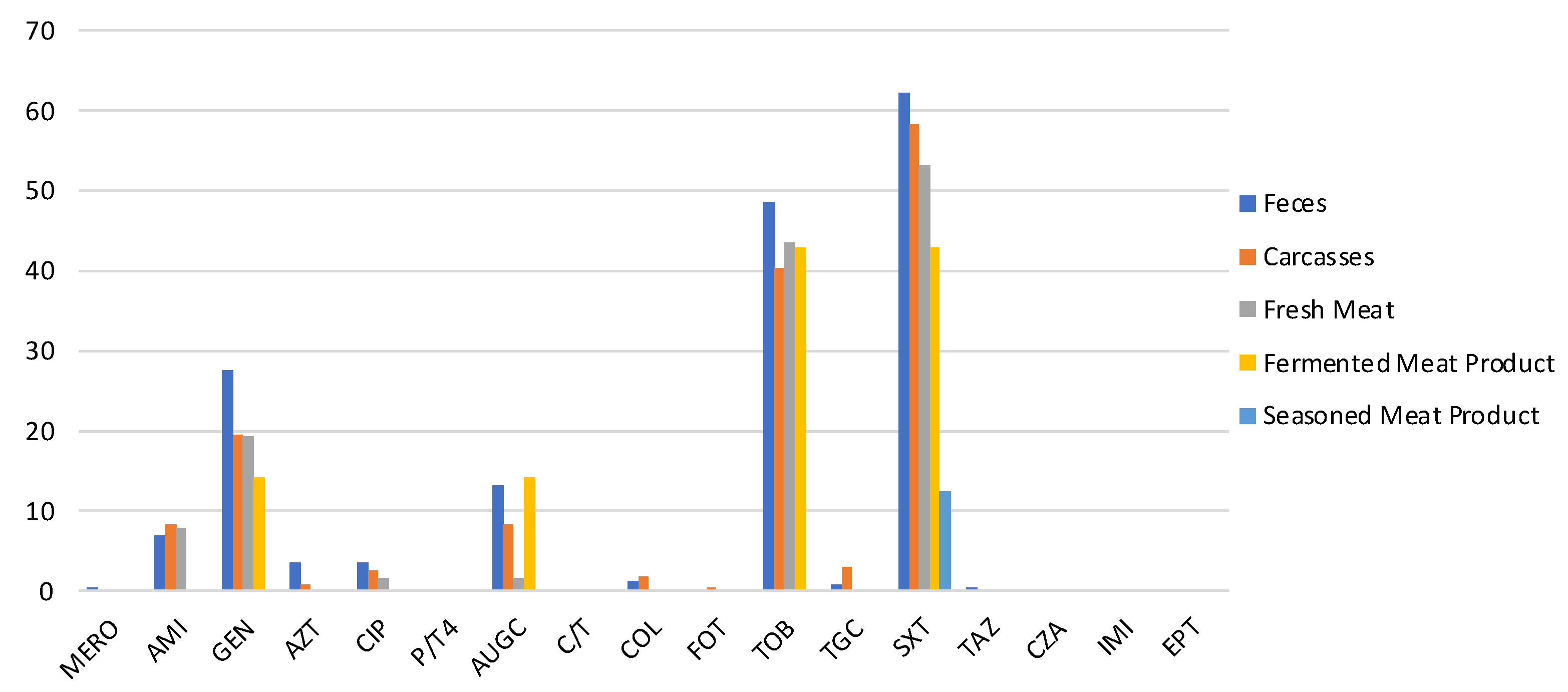
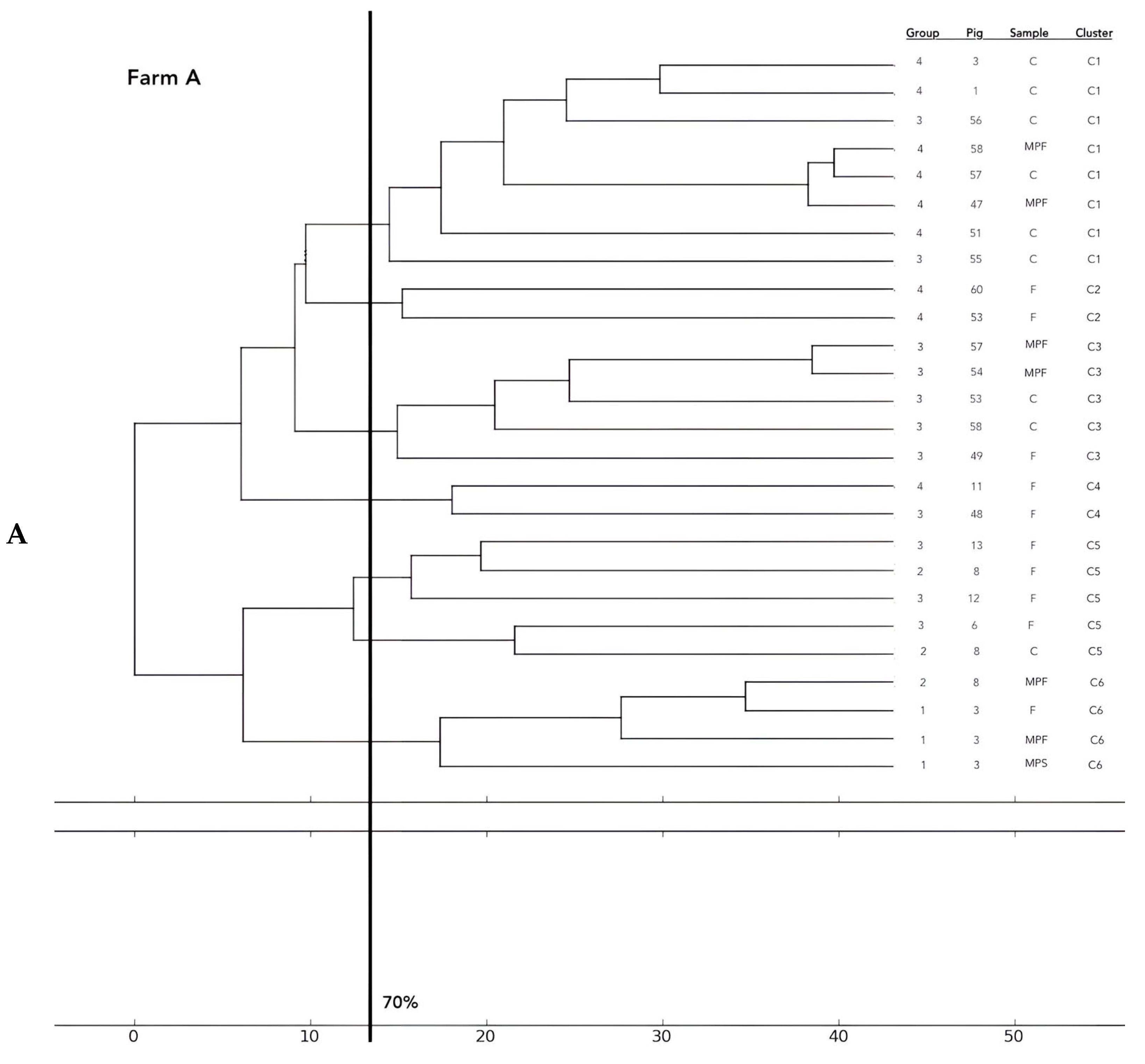

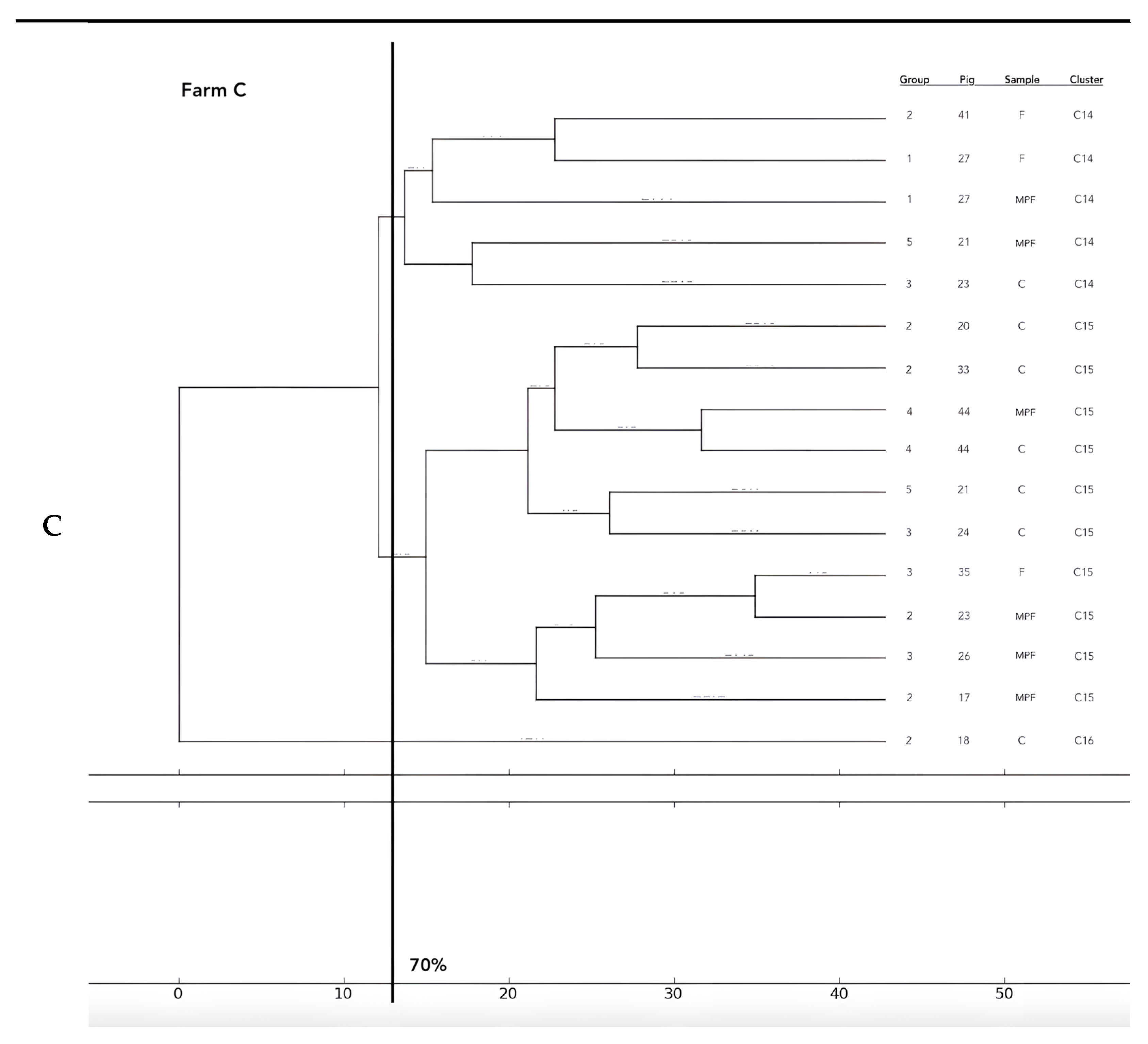
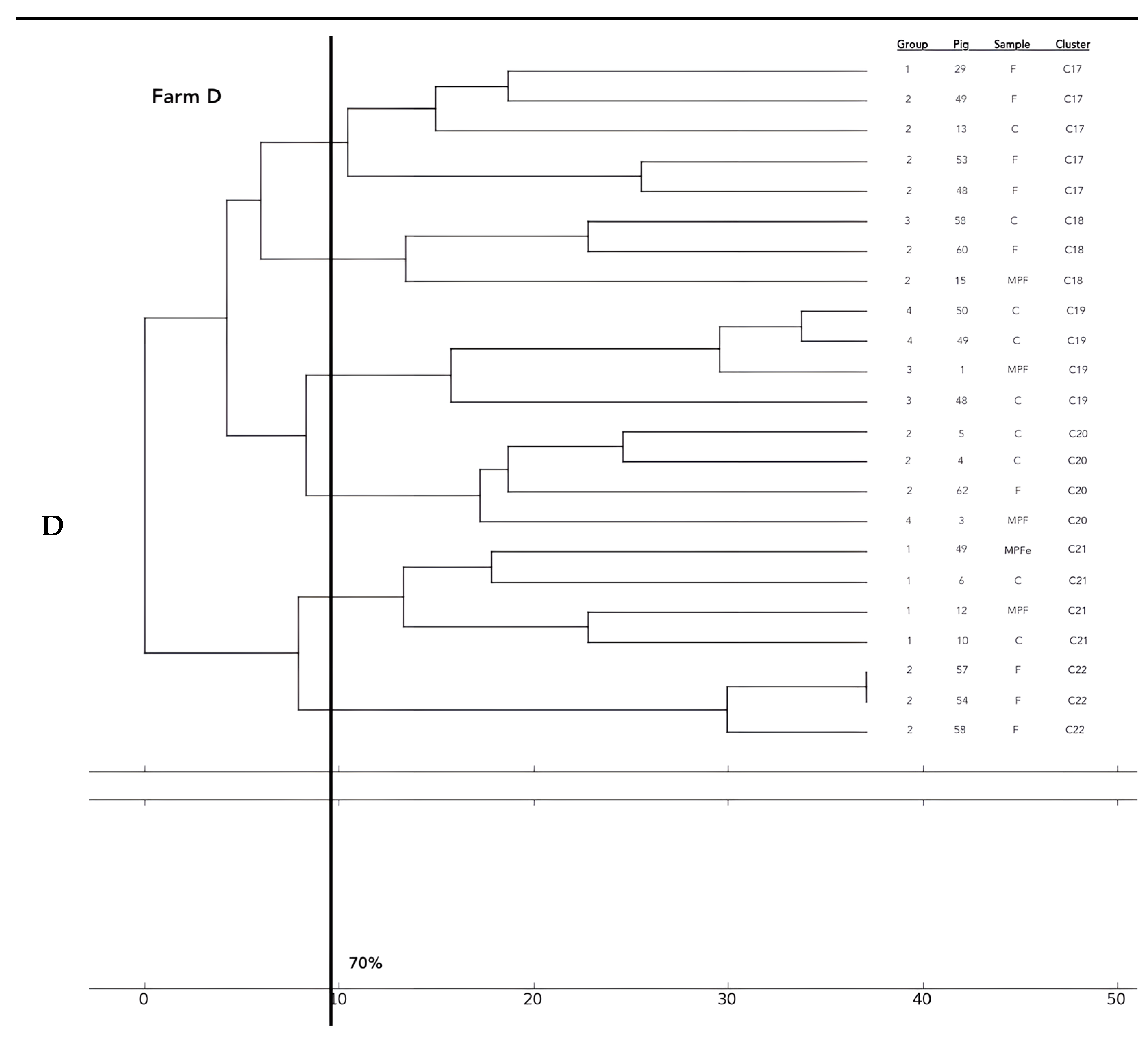
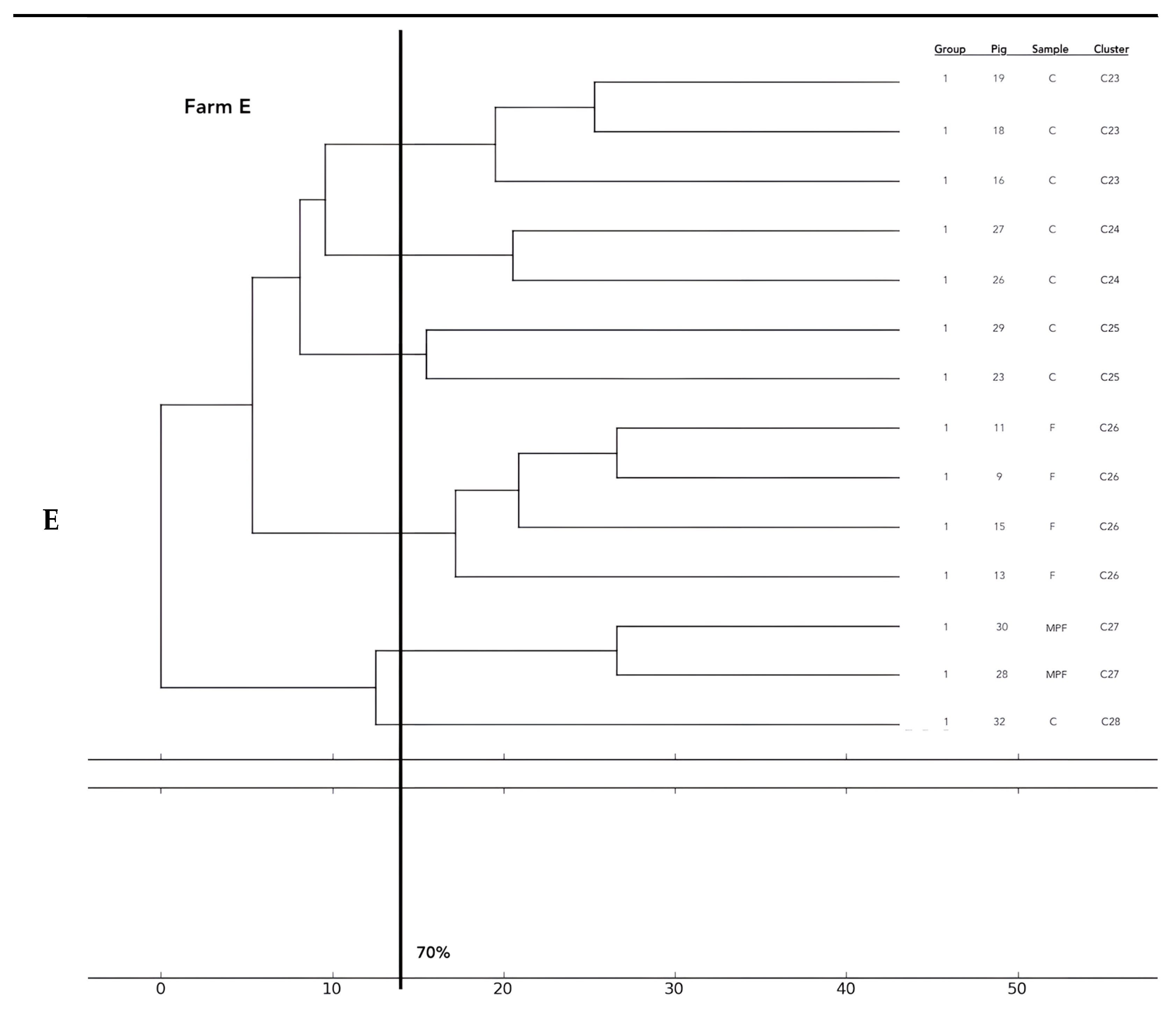
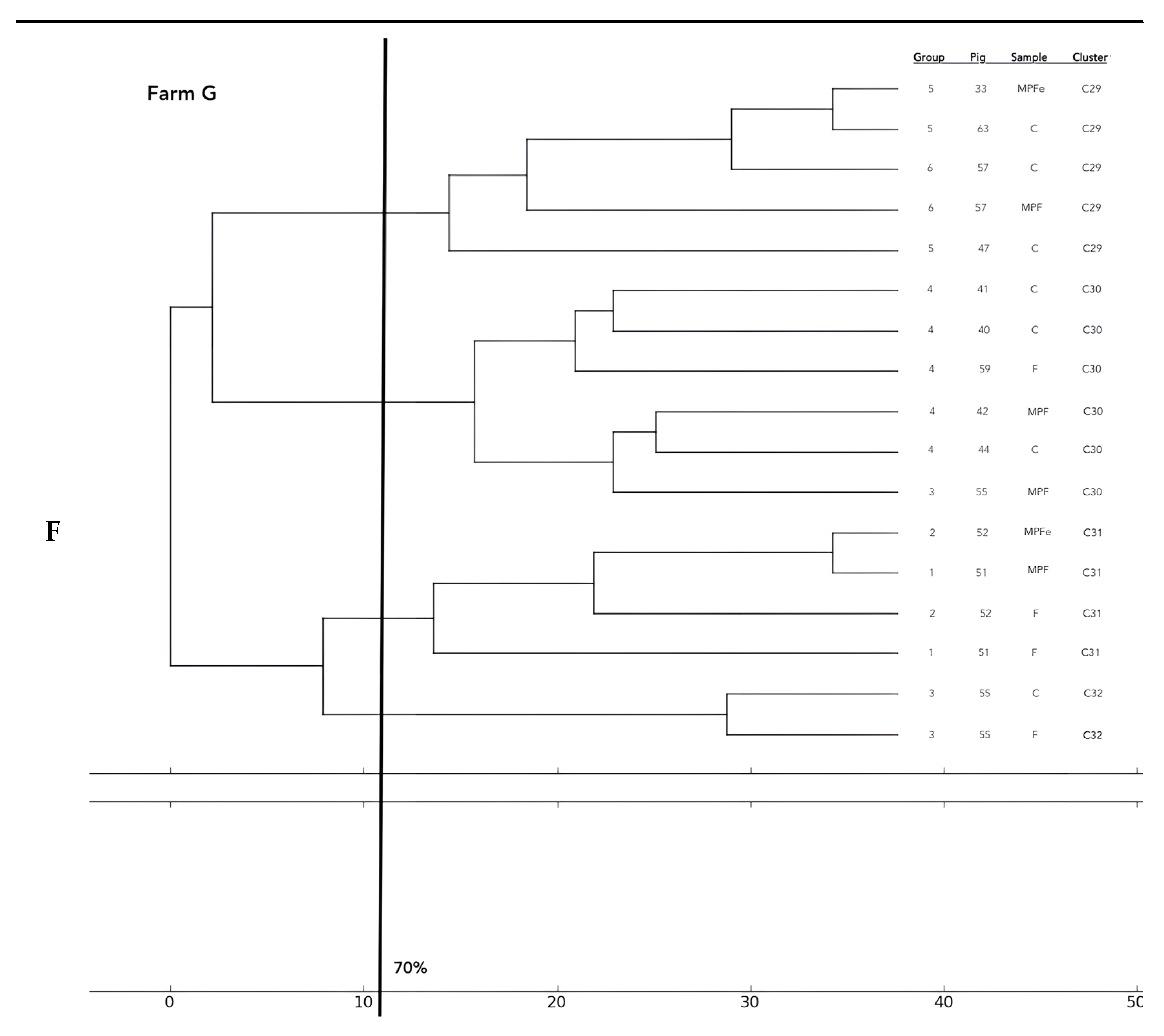

| Farm | Resistance Pattern | Feces | Carcasses | Fresh Meat | Fermented Meat Product | Seasoned Meat Product |
|---|---|---|---|---|---|---|
| A | SXT | Pig 3 | Pig 3 | Pig 3 | ||
| Pig 8 | Pig 8 | Pig 8 | ||||
| B | SXT-TOB | Pig 34 | Pig 34 | |||
| C | SXT | Pig 44 | Pig 44 | |||
| SXT-TOB | Pig 27 | Pig 27 | ||||
| Pig 21 | Pig 21 | |||||
| F | AMI-GEN TOB-SXT | Pig 46 | Pig 46 | |||
| G | SXT | Pig 57 | Pig 57 | |||
| SXT-TOB | Pig 51 | Pig 51 | ||||
| Pig 52 | Pig 52 | |||||
| Pig 55 | Pig 55 | Pig 55 | ||||
| H | SXT-TOB | Pig 9 | Pig 9 |
| Farm | Resistance Pattern | Group | Feces | Carcasses | Fresh Meat | Fermented Meat Product | Seasoned Meat Product |
|---|---|---|---|---|---|---|---|
| A | SXT-TOB | 3 | Pig 6, 12, 13, 48, 49 | Pig 53, 55, 56, 58 | Pig 54, 57 | ||
| GEN-TOB-SXT | 4 | Pig 11, 53, 60 | Pig 1, 3, 51, 57 | Pig 47, 58 | |||
| B | SXT | 1 | Pig 36, 37 | Pig 32, 33, 38, 39, 41, 45 | Pig 35, 42 | ||
| GEN-TOB-SXT | 2 | Pig 18, 40, 46 | Pig 36 | Pig 44 | |||
| C | GEN-TOB-SXT | 2 | Pig 41 | Pig 33, 18, 20 | Pig 17, 23 | ||
| GEN-TOB | 3 | Pig 35 | Pig 23, 24 | Pig 26 | |||
| D | SXT-TOB | 1 | Pig 29 | Pig 6, 10 | Pig 12 | Pig 49 | |
| GEN-TOB-SXT | 2 | Pig 48, 49, 53, 54, 57, 58, 60, 62 | Pig 4, 5, 13 | Pig 15 | |||
| AUGC | 3 | Pig 48, 58 | Pig 1 | ||||
| CIP | 4 | Pig 49, 50 | Pig 3 | ||||
| E | SXT-TOB | 1 | Pig 9, 11, 13, 15 | Pig 16, 18, 19, 23, 26, 27, 29, 32 | Pig 28, 30 | ||
| G | AMI-GEN-TOB-SXT | 4 | Pig 59 | Pig 40, 41, 44 | Pig 42 | ||
| GEN-TOB-SXT | 5 | Pig 47, 63 | Pig 33 | ||||
| H | GEN-TOB-SXT | 1 | Pig 50 | Pig 8 | |||
| TOB | 2 | Pig 52, 53 | Pig 1 | Pig 13 |
Disclaimer/Publisher’s Note: The statements, opinions and data contained in all publications are solely those of the individual author(s) and contributor(s) and not of MDPI and/or the editor(s). MDPI and/or the editor(s) disclaim responsibility for any injury to people or property resulting from any ideas, methods, instructions or products referred to in the content. |
© 2023 by the authors. Licensee MDPI, Basel, Switzerland. This article is an open access article distributed under the terms and conditions of the Creative Commons Attribution (CC BY) license (https://creativecommons.org/licenses/by/4.0/).
Share and Cite
Rega, M.; Andriani, L.; Poeta, A.; Bonardi, S.; Conter, M.; Bacci, C. The Pork Food Chain as a Route of Transmission of Antimicrobial Resistant Escherichia coli: A Farm-to-Fork Perspective. Antibiotics 2023, 12, 376. https://doi.org/10.3390/antibiotics12020376
Rega M, Andriani L, Poeta A, Bonardi S, Conter M, Bacci C. The Pork Food Chain as a Route of Transmission of Antimicrobial Resistant Escherichia coli: A Farm-to-Fork Perspective. Antibiotics. 2023; 12(2):376. https://doi.org/10.3390/antibiotics12020376
Chicago/Turabian StyleRega, Martina, Laura Andriani, Antonio Poeta, Silvia Bonardi, Mauro Conter, and Cristina Bacci. 2023. "The Pork Food Chain as a Route of Transmission of Antimicrobial Resistant Escherichia coli: A Farm-to-Fork Perspective" Antibiotics 12, no. 2: 376. https://doi.org/10.3390/antibiotics12020376





